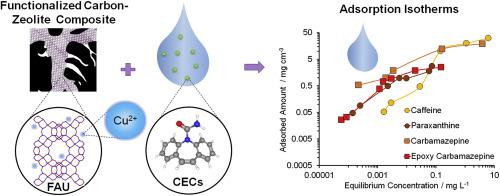Microporous and Mesoporous Materials ( IF 4.8 ) Pub Date : 2020-06-24 , DOI: 10.1016/j.micromeso.2020.110355 Bethzaely Fernández-Reyes , Stefannie Morales-Jiménez , Juan C. Muñoz-Senmache , Dariana R. Vega-Santander , Arturo J. Hernández-Maldonado

|
A copper(II) functionalized hierarchical faujasite zeolite/activated carbon composite adsorbent (Cu-CFAU) was prepared in an attempt to develop a platform for the effective removal of contaminants of emerging concern (CECs: caffeine, carbamazepine, and metabolites clofibric acid, 10,11-epoxy-carbamazepine naproxen, o-desmethylnaproxen, paraxanthine, salicylic acid) from water at ambient conditions. CFAU was prepared hydrothermally via seeded in situ growth of zeolite crystals within the pores of an activated carbon (AC, Darco-KB-G) and subsequently exchanged with copper(II). The materials were characterized using XRD, TEM, TGA, porosimetry, and elemental analysis. TEM, TGA and textural properties showed direct evidence of the in situ growth of the zeolite phase. Performance of the CFAU composite for CECs equilibrium adsorption was addressed in both single and multi-component fashion and for CECs aqueous phase concentrations covering the μg L−1 – mg L−1 range. Cu-CFAU displayed the best overall adsorption working capacities, probably due to greater affinity for all CECs by relying on complexation interaction with the transition metal sites along with an enhancement of electrostatic and hydrophobic-hydrophilic interactions. Compared to AC, the composite excelled in adsorbing ionic CECs and was able to offer at least equal capacity toward neutral CECs. Compared to other adsorbents reported so far in the literature, the Cu-CFAU offers adsorption capacities that are larger by an order of magnitude in many cases. Preliminary tests for the reusability of the composite after various adsorption/desorption cycles suggest that Cu-CFAU might be regenerated via thermal treatment under inert atmosphere when the adsorbed CEC possesses a relative low melting point.
中文翻译:

从水及其代谢产物中选出的新兴污染物的单组分和多组分吸附到分级多孔铜(II)-沸石活化的碳复合材料上
制备了铜(II)功能化的分层八面沸石/活性炭复合吸附剂(Cu-CFAU),以期开发出一个平台,可有效去除新兴关注的污染物(CEC:咖啡因,卡马西平和代谢产物氯纤维酸,10在环境条件下,从水中制得(11,11-环氧-卡马西平萘普生,邻-去甲基萘普生,对黄嘌呤,水杨酸)。CFAU是通过在活性炭(AC,Darco-KB-G)的孔内原位生长沸石晶体进行水热法制备的,然后与铜(II)交换。使用XRD,TEM,TGA,孔隙率法和元素分析对材料进行表征。TEM,TGA和组织性质显示了原位的直接证据沸石相的生长。CFAU复合材料对CECs平衡吸附的性能以单组分和多组分形式以及CECs水相浓度覆盖μgL -1 – mg L -1的方式解决。范围。Cu-CFAU表现出最佳的总体吸附工作能力,这可能是由于它依赖于与过渡金属位点的络合相互作用以及对静电和疏水-亲水相互作用的增强,对所有CEC都具有更高的亲和力。与AC相比,该复合材料在吸附离子CEC方面表现出色,并且能够提供至少相等的中性CEC容量。与文献中迄今为止报道的其他吸附剂相比,Cu-CFAU在许多情况下提供的吸附能力要大一个数量级。各种吸附/解吸循环后复合材料可重复使用性的初步测试表明,当吸附的CEC具有相对较低的熔点时,Cu-CFAU可能会通过在惰性气氛下进行热处理而再生。











































 京公网安备 11010802027423号
京公网安备 11010802027423号